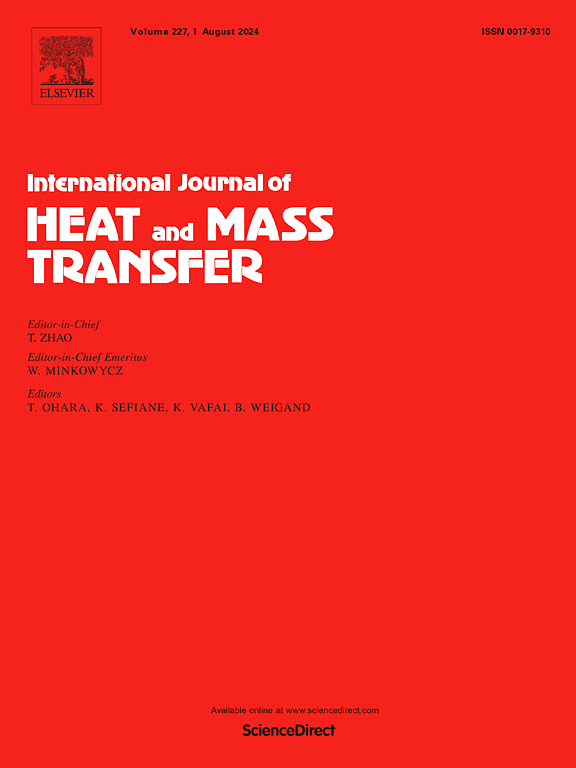基于反应分子动力学模拟的二氧化硅热保护材料异相催化动力学蒙特卡罗模型
IF 5
2区 工程技术
Q1 ENGINEERING, MECHANICAL
International Journal of Heat and Mass Transfer
Pub Date : 2024-11-02
DOI:10.1016/j.ijheatmasstransfer.2024.126378
引用次数: 0
摘要
热防护材料上发生的化学解离原子的异相催化重组大大增加了高速飞机所承受的热负荷,但微观反应动力学的复杂性给在宏观传热和传质计算的背景下对其进行分析带来了巨大挑战。反应分子动力学(RMD)方法有助于模拟气体与表面相互作用的复杂化学机制,但高昂的计算成本限制了其在较大时空尺度上的应用。为了快速获得热防护材料表面离解原子催化的时间演化,并为高速流场的数值模拟提供反应边界条件,我们开发了一种针对这一现象的动力学蒙特卡洛(KMC)算法。利用适当的后处理方法,从基于 ReaxFF 的分子动力学模拟中提取了基本反应步骤的速率参数。基本反应步骤和活性位点构型被整合到基于 RMD 的 KMC 算法中,以适应硅热保护材料催化反应的特点。事实证明,基于 RMD 的 KMC 建模方法在预测重组系数和表面构型方面准确高效,误差小于 15%。与 RMD 模拟相比,KMC 建模大大降低了表面反应动力学的计算成本,降低了约 2 × 105 倍。基于 RMD 的 KMC 方法有助于分子水平研究与连续计算之间的跨尺度耦合。本文章由计算机程序翻译,如有差异,请以英文原文为准。
Kinetic Monte Carlo modeling of heterogeneous catalysis on silica thermal protective materials based on reactive molecular dynamics simulation
Heterogeneous catalytic recombination of chemically dissociated atoms occurring on thermal protective materials significantly increases the thermal load borne by high-speed aircraft, but the intricate nature of microscopic reaction dynamics poses a formidable challenge in its analysis within the context of macroscopic heat and mass transfer calculations. Reactive molecular dynamics (RMD) method is helpful in simulating the complicated chemical mechanisms of the gas-surface interaction, while the high computational cost limits its application to larger spatial and temporal scales. To quickly obtain the time evolution of surface catalysis of dissociated atoms on thermal protective materials and provide reactive boundary conditions for numerical simulation of the high-speed flow field, a kinetic Monte Carlo (KMC) algorithm specified for this phenomenon was developed. Rate parameters of the elementary reaction steps were extracted from ReaxFF-based molecular dynamics simulation using proper post-processing method. Elementary reaction steps and active site configuration were integrated into the RMD-based KMC algorithm to cater to the characteristics of catalysis on silica thermal protective materials. The RMD-based KMC modeling method was proved to be accurate and efficient in predicting the recombination coefficients and surface configuration, with an error of less than 15 %. Compared to RMD simulations, the KMC modeling significantly reduces the computational cost of surface reaction dynamics by approximately 2 × 105 times. RMD-based KMC method can contribute to the cross-scale coupling between molecular-level research and continuum computation.
求助全文
通过发布文献求助,成功后即可免费获取论文全文。
去求助
来源期刊
CiteScore
10.30
自引率
13.50%
发文量
1319
审稿时长
41 days
期刊介绍:
International Journal of Heat and Mass Transfer is the vehicle for the exchange of basic ideas in heat and mass transfer between research workers and engineers throughout the world. It focuses on both analytical and experimental research, with an emphasis on contributions which increase the basic understanding of transfer processes and their application to engineering problems.
Topics include:
-New methods of measuring and/or correlating transport-property data
-Energy engineering
-Environmental applications of heat and/or mass transfer

 求助内容:
求助内容: 应助结果提醒方式:
应助结果提醒方式:


